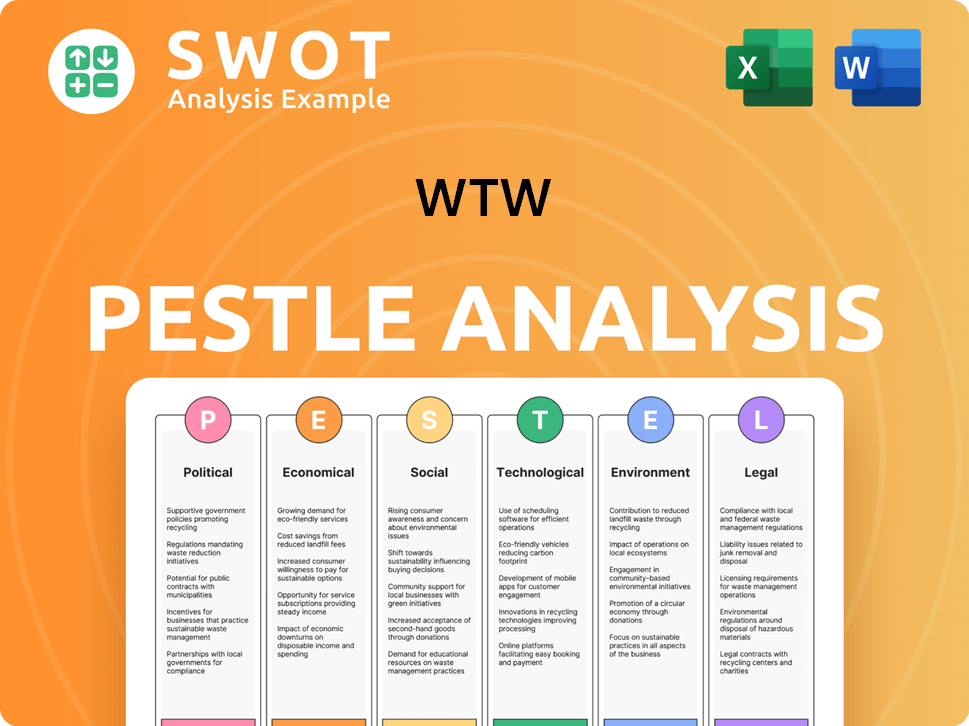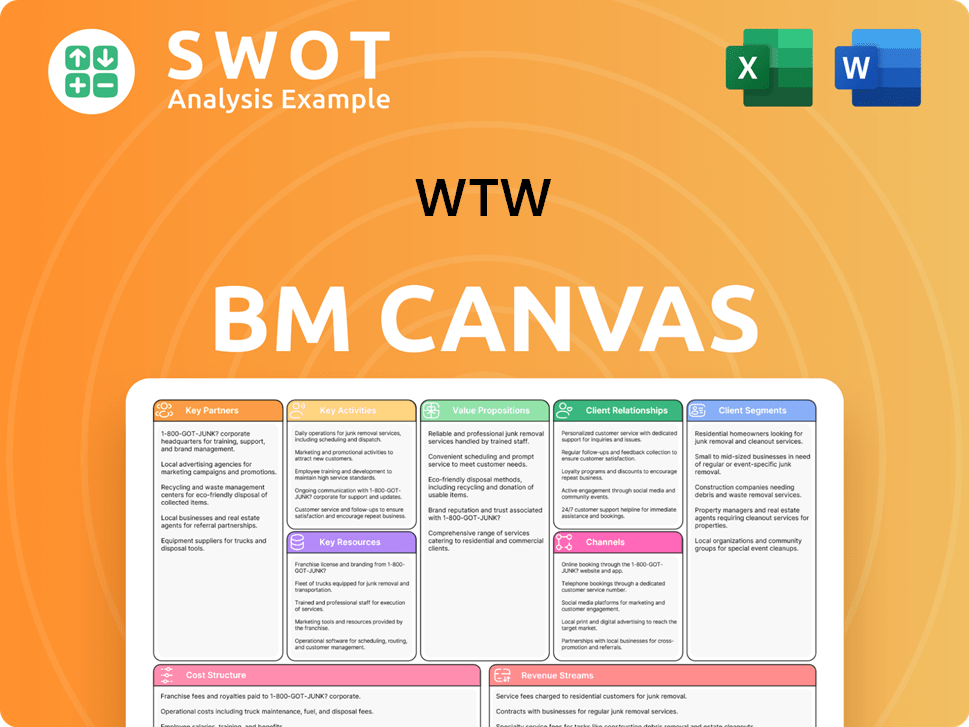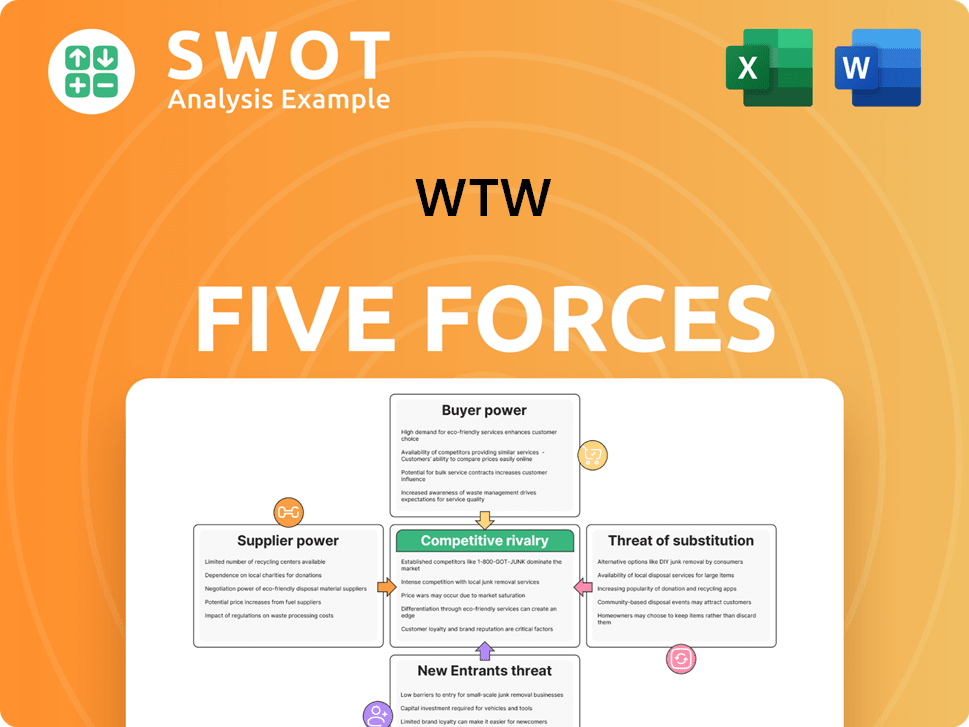WTW Bundle
Who Really Owns WTW Company?
Understanding the ownership structure of Willis Towers Watson (WTW) is crucial for investors and industry watchers alike. From its origins to its current status, the evolution of WTW's ownership has shaped its strategic direction and market position. A deep dive into the WTW company reveals key players and influences that drive its performance.

The WTW SWOT Analysis provides a detailed look at the company's strengths, weaknesses, opportunities, and threats, all heavily influenced by its ownership dynamics. Knowing who controls WTW and who the major WTW shareholders are offers valuable insights. Examining the company's history, including its merger and acquisitions, helps to understand the current WTW ownership and its impact on the firm's global operations and financial performance.
Who Founded WTW?
The story of WTW ownership is rooted in the histories of several key companies: Willis Group, Towers Perrin, and Watson Wyatt Worldwide. These entities, each with their own founders and early ownership structures, eventually merged to form the global firm we know today. Understanding the origins of these companies provides insight into the evolution of Willis Towers Watson, its strategic direction, and its current ownership.
The foundational elements of WTW company trace back to the 19th and 20th centuries. Henry Willis established Henry Willis & Company in 1828, focusing on marine insurance. In the U.S., Towers, Perrin, Forster & Crosby (TPF&C) was founded in 1934, and R. Watson & Sons was formed in 1878 by Reuben Watson in the UK. The U.S.-based Wyatt Company was established in 1946 by B.E. Wyatt and seven co-founders.
Early ownership agreements and strategic alliances played a crucial role in shaping the future company. R. Watson & Sons and The Wyatt Company formed a global alliance in 1995, leading to the creation of Watson Wyatt. In 1997, Willis Corroon was privatized in a $1.4 billion deal by Kohlberg Kravis Roberts, and by 1998, all Willis operations were amalgamated under the name Willis Group. Watson Wyatt was listed on the New York Stock Exchange in 2000. These early phases saw various firms building out their businesses and global presence through acquisitions and mergers, reflecting the founders' visions for comprehensive risk and human capital solutions.
The evolution of Willis Towers Watson is a story of strategic mergers and acquisitions, reflecting the founders' visions for comprehensive risk and human capital solutions. The company's structure has been shaped by key decisions that have influenced its global presence and market position. For more details, you can read the Brief History of WTW.
- 1828: Henry Willis & Company is founded.
- 1934: Towers, Perrin, Forster & Crosby (TPF&C) is established.
- 1946: The Wyatt Company is founded.
- 1995: R. Watson & Sons and The Wyatt Company form a global alliance.
- 1997: Willis Corroon is privatized.
- 1998: Willis operations are amalgamated under the name Willis Group.
- 2000: Watson Wyatt is listed on the New York Stock Exchange.
WTW SWOT Analysis
- Complete SWOT Breakdown
- Fully Customizable
- Editable in Excel & Word
- Professional Formatting
- Investor-Ready Format

How Has WTW’s Ownership Changed Over Time?
The evolution of WTW's ownership reflects a series of strategic mergers and acquisitions. The journey began in 2010 with the merger of Towers Perrin and Watson Wyatt Worldwide, forming Towers Watson, a move valued at $4 billion. This created a leading employee-benefits consulting firm by revenue. The next significant shift occurred in 2016 when Towers Watson merged with Willis Group, resulting in Willis Towers Watson. This merger, structured as a 'merger of equals,' saw the combined entity go public on January 5, 2016, listed on Nasdaq.
The initial public offering (IPO) of WTW, with an opening share price of $108.16, marked a pivotal moment. The company’s structure is now defined by its status as a public entity, with ownership primarily distributed among institutional investors, mutual funds, and individual insiders. As a publicly traded company, WTW’s financial performance and strategic decisions are subject to scrutiny from a broad base of shareholders. The company's financial health is reflected in its reported figures, such as the total assets of $27.7 billion and total equity of $7.94 billion for the year ended December 31, 2024.
| Key Event | Date | Impact on Ownership |
|---|---|---|
| Towers Perrin and Watson Wyatt Merger | 2010 | Formation of Towers Watson, a leading consulting firm. |
| Willis Group and Towers Watson Merger | 2016 | Creation of Willis Towers Watson; Initial Public Offering (IPO). |
| Ongoing | Present | Public company status, with ownership primarily held by institutional investors and individual insiders. |
As a publicly traded entity, understanding the dynamics of WTW shareholders and their influence is key. Major stakeholders shape the company's strategic direction and governance. Detailed information on major shareholders is available through SEC filings, such as 10-K and 10-Q reports, which are accessible on the investor relations section of the company's website. For further insights into the company's strategic direction, consider exploring the Growth Strategy of WTW.
WTW is a public company, with ownership primarily held by institutional investors.
- The company's history includes significant mergers, such as the combination of Towers Perrin and Watson Wyatt Worldwide, and the merger with Willis Group.
- WTW is traded on the Nasdaq under the ticker WTW.
- The company's financial performance, including total assets and equity, is reported annually.
- Major shareholders influence WTW's strategy and governance.
WTW PESTLE Analysis
- Covers All 6 PESTLE Categories
- No Research Needed – Save Hours of Work
- Built by Experts, Trusted by Consultants
- Instant Download, Ready to Use
- 100% Editable, Fully Customizable

Who Sits on WTW’s Board?
The Board of Directors of the WTW company plays a vital role in its governance, representing the interests of its WTW shareholders. Key figures include Paul Thomas as chairman, and Carl Hess as CEO. Inga Beale also serves as a director. The board's composition and committee structures are detailed in proxy statements and annual reports available on the investor relations website. Understanding the WTW ownership structure is key for investors.
As a publicly traded entity on Nasdaq, WTW generally adheres to a one-share-one-vote structure. This is standard for most public companies. Information regarding special voting rights or shares that would grant outsized control to specific individuals or entities is not available in the provided context. The company's governance includes executive compensation plans that incorporate environmental, social, and governance (ESG) factors, reflecting industry trends.
| Board Member | Position | Key Role |
|---|---|---|
| Paul Thomas | Chairman | Oversees board activities and strategic direction. |
| Carl Hess | CEO & Director | Leads the company's operations and strategic initiatives. |
| Inga Beale | Director | Provides oversight and guidance on company matters. |
In fiscal year 2024, Carl Hess, the CEO, had a total compensation of $12,502,090, with a CEO to median employee pay ratio of 256:1. For those looking to understand more about the company's focus, considering the Target Market of WTW can provide additional insights.
The Board of Directors at WTW is responsible for overseeing the company's strategic direction and representing shareholder interests.
- Paul Thomas serves as chairman, and Carl Hess is the CEO.
- WTW operates under a standard one-share-one-vote structure.
- Executive compensation includes ESG factors.
- Detailed information is available in proxy statements and annual reports.
WTW Business Model Canvas
- Complete 9-Block Business Model Canvas
- Effortlessly Communicate Your Business Strategy
- Investor-Ready BMC Format
- 100% Editable and Customizable
- Clear and Structured Layout

What Recent Changes Have Shaped WTW’s Ownership Landscape?
Over the past few years, the WTW company has seen significant shifts in its ownership and strategic direction. A notable event was the failed acquisition by Aon in July 2021, a deal valued at approximately $30 billion. This would have combined two of the industry's largest brokers, but it was blocked due to antitrust concerns, leading to a $1 billion termination fee paid by Aon. These events have shaped the landscape of WTW ownership.
In terms of shareholder returns and capital allocation, WTW has been actively repurchasing shares. For the year ending December 31, 2024, the company repurchased $901 million of its shares, including $395 million in the fourth quarter of 2024. Looking ahead, WTW anticipates share repurchases of about $1.5 billion in 2025, subject to market conditions and investment opportunities. The company also reported a net loss of $88 million for 2024, primarily due to over $1.0 billion in impairment charges related to the sale of its TRANZACT business, which was completed in January 2025. These financial moves highlight the evolving dynamics of Willis Towers Watson owner interests.
| Metric | Year Ended December 31, 2024 | Year Ended December 31, 2023 |
|---|---|---|
| Share Repurchases | $901 million | N/A |
| Net Loss | $88 million | N/A |
| Impairment Charges | over $1.0 billion | N/A |
Industry trends show a growing emphasis on institutional ownership. WTW's strategic actions, including portfolio optimization through organic and inorganic investments, indicate an ongoing evolution of its ownership structure and business mix. Carl Hess, who became CEO in January 2022, is focused on accelerating performance and enhancing efficiency. Further insights into these trends and future plans are available through the company's investor days and financial presentations, offering details on WTW shareholders and their interests.
WTW is a publicly traded company, so its ownership is spread among various institutional investors and individual shareholders. The largest shareholders typically include institutional investors such as investment management firms and mutual funds. Knowing who controls WTW involves understanding the major institutional holdings.
WTW's financial performance is crucial for understanding its ownership dynamics. The company's financial results, including revenue, earnings, and cash flow, influence investor confidence and stock valuation. Analyzing WTW financial performance helps assess the company's ability to generate returns for its shareholders.
Understanding the WTW company history and background provides context for its current ownership structure. The company's past mergers, acquisitions, and strategic decisions have shaped its shareholder base and overall direction. This history is vital for anyone researching Willis Towers Watson.
The leadership of WTW, including the CEO and other key executives, plays a significant role in shaping the company's strategy and influencing its ownership dynamics. The decisions and vision of WTW company leadership directly affect shareholder value and company performance.
WTW Porter's Five Forces Analysis
- Covers All 5 Competitive Forces in Detail
- Structured for Consultants, Students, and Founders
- 100% Editable in Microsoft Word & Excel
- Instant Digital Download – Use Immediately
- Compatible with Mac & PC – Fully Unlocked

Related Blogs
- What are Mission Vision & Core Values of WTW Company?
- What is Competitive Landscape of WTW Company?
- What is Growth Strategy and Future Prospects of WTW Company?
- How Does WTW Company Work?
- What is Sales and Marketing Strategy of WTW Company?
- What is Brief History of WTW Company?
- What is Customer Demographics and Target Market of WTW Company?
Disclaimer
All information, articles, and product details provided on this website are for general informational and educational purposes only. We do not claim any ownership over, nor do we intend to infringe upon, any trademarks, copyrights, logos, brand names, or other intellectual property mentioned or depicted on this site. Such intellectual property remains the property of its respective owners, and any references here are made solely for identification or informational purposes, without implying any affiliation, endorsement, or partnership.
We make no representations or warranties, express or implied, regarding the accuracy, completeness, or suitability of any content or products presented. Nothing on this website should be construed as legal, tax, investment, financial, medical, or other professional advice. In addition, no part of this site—including articles or product references—constitutes a solicitation, recommendation, endorsement, advertisement, or offer to buy or sell any securities, franchises, or other financial instruments, particularly in jurisdictions where such activity would be unlawful.
All content is of a general nature and may not address the specific circumstances of any individual or entity. It is not a substitute for professional advice or services. Any actions you take based on the information provided here are strictly at your own risk. You accept full responsibility for any decisions or outcomes arising from your use of this website and agree to release us from any liability in connection with your use of, or reliance upon, the content or products found herein.